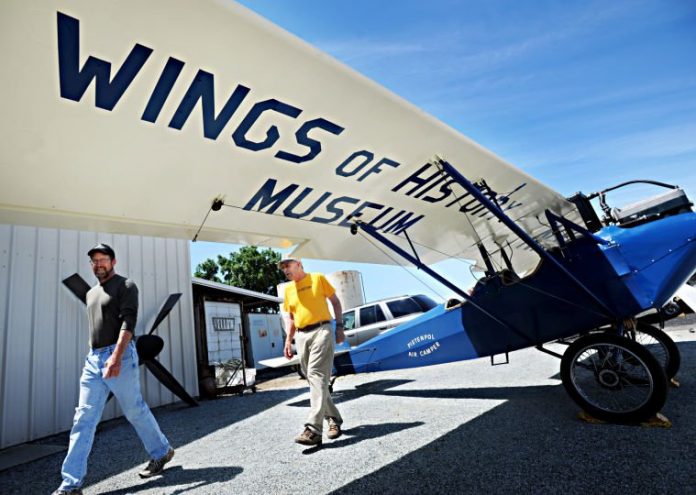
Sometimes museums educate visitors with flat, dusty displays and information plaques, maybe a button to push to hear a pre-recorded message or a pleasant voice that speaks through an audio headset. But in San Martin, you’ll find so much more.
The Wings of History Air Museum has been intriguing and exciting the public for free—though donations are accepted—since 1992.
What makes the museum so rewarding is its knowledgeable and engaging docents, including Vernon Hayashida, who walks visitors through various exhibits and explains the history behind them.
Docents offer intricate tales that help attendees visualize what it must have been like to experience the first Wright Brothers’ flights at Kitty Hawk, N.C., how it feels to fly a plane and even what children did when flying was a just a dream and model airplanes were their toys.
One of the many volunteers who keep the nonprofit corporation running is Susan Talbot, office manager and treasurer of the museum.
“There are about 150 members who financially support the museum, of which there are up to 20 docents,” she said. “At the annual Fly-In and Air Show, up to 100 members volunteer to make it a very successful event.”
The Wings of History Air Museum is known for the annual Fly-In and Air Show. Together with South County Airport and the South County Airport Pilots Association, the museum showcases aircraft exhibits and antique airplanes that actually fly.
Talbot and Hayashida said the event offers a little something for children and adults alike, including farm equipment demonstrations, hit-and-miss engines that sound like they’re on the brink of failing, antique cars, free plane and helicopter rides—provided by the Young Eagles Program of the Experimental Aircraft Association—for kids ages 8 to 17, a flight simulator, square dancing and rides in a tethered hot air balloon.
“The museum held its 14th Fly-In last May,” Talbot said, adding the event is held every year on the Saturday following Mother’s Day and draws nearly 2,000 visitors.
The museum’s exhibits are spread out among three large buildings. A fourth building is used as a meeting and lunchroom and can be rented by the public.
“That building was moved from the old Morgan Hill Airport, which was demolished to make room for the shopping center at Cochrane (Road) and Highway 101,” Talbot said.
The Harold C. Bosshardt Restoration Shop includes a restoration area as well as the Gift Shoppe, where visitors can purchase model aircraft kits and more.
The restoration area was the first to be built and is used to rebuild antique airplanes. Museum patrons who visit on a weekday might observe volunteer workers rebuilding planes, just as some did in the early 20th century.
If you think women were not pilots, think again. The Wings of History Air Museum is home to a large historical display featuring Women in Aviation.
“Although there were women breaking into aviation early in aviation history, it was expected that they dress like the women of their times,” Hayashida said. “For example, no pants. Imagine flying in a open cockpit with a dress, while handling (a plane) with a steering stick between your legs.”
The Ole Fahlin Memorial Propeller Shop is where visitors will find volunteers creating and working on various propellers-and the smell might bring back memories of Woodshop 101 from junior high school.
“This shop is a FAA-certified repair station, repairing and rebuilding wooden propellers,” Talbot said.
Ole Fahlin came from Sweden in the 1920s and was pilot-certified by Wilbur Wright. He was known for creating wooden propellers and had shops across America, one located at The Flying Lady Restaurant, a one-time popular tourist destination in Morgan Hill. Fahlin shared his skills with Guy Watson, who eventually moved the shop to the museum a few years ago.
“A typical propeller starts off as 150 pounds of wood,” Hayashida said. “It is shaped, shaved and sanded down to 30 pounds when done.”
Most of the aircraft exhibits are located in display hangar No. 1 and display hangar No. 2. Both are used for aircraft restoration as well, along with housing antique aircraft. Restoration on planes is at different stages, all with the purpose of each plane being flown in the annual Fly-In and Air Show or becoming a restored display for the museum.
An interactive replica of the Wright Brothers’ airplane is also on display, with a life-size mannequin pilot. Push a button and the aircraft propellers rotate.
“This aircraft was flown about four times in total before it crashed, but that was enough for the brothers,” Hayashida said.
Large airplane models, including an all-electric one, can be found looking toward the heavens, hung from the museum’s ceiling.
“There are about 130 of these models, of which 60 were previously displayed at The Flying Lady,” Talbot said. “Irv Perch, who once owned The Flying Lady, donated the land where the air museum now sits. The Flying Lady is named for his wife, who flew airplanes.”
Visitors may find it hard to believe that airplane models from the late ‘40s and ‘50s were made of cardboard instead of plastic, or that bench airplane models—such as models for the B-17, B-24, B-25 and B-29 bombers—were built from scratch using drawings.
For those with fingers hungry to touch, the museum offers a flight simulator where anyone can try their hand at flying. The simulator begins by taking off from the South County Airport runway and flies over north Morgan Hill. Though the “pilot” is in control, a docent guides him or her to the end of Morgan Hill and back, landing at the same airport.
The Wings of History Air Museum is open from 10 a.m. to 3 p.m. Tuesday and Thursday, and 11 a.m. to 4 p.m. Saturday. Visits are free, with a suggested $7 donation for adults and $5 for children. For more information, call Talbot at (408) 683-2290 or visit wingsofhistory.org.












